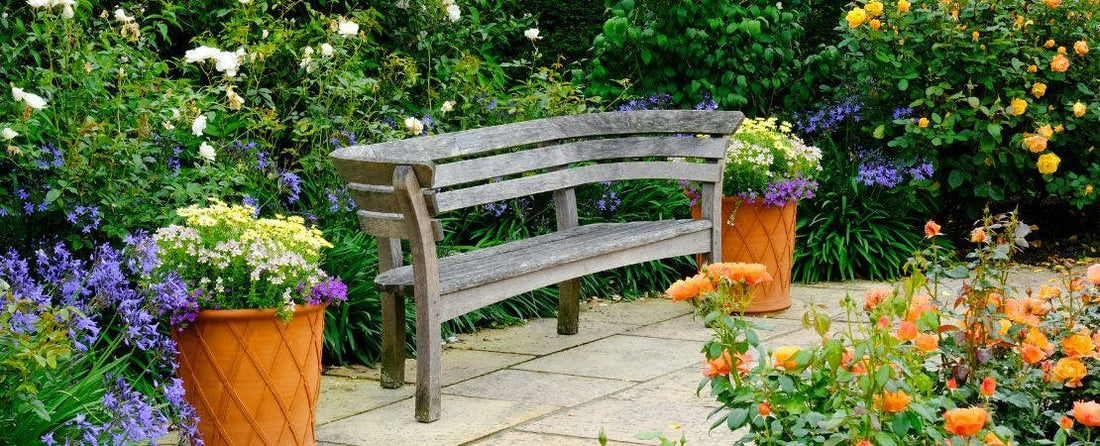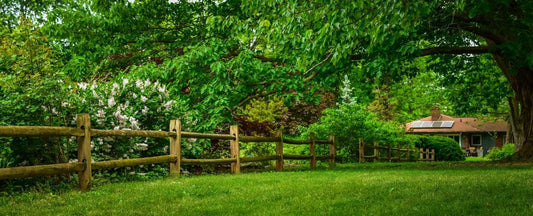Container Garden Tips & Ideas for a Garden You Can Grow Anywhere

Container Gardening Let’s You Grow a Beautiful Garden in the Space You Have
A container garden offers flexibility, creativity, and beauty—no matter where you live. Container gardens work in tight spaces, open landscapes, and everything in between. They’re one of the simplest ways to grow flowers, herbs, shrubs, and even trees—without needing a dedicated garden bed.
If you’re new to gardening, containers are a smart place to start. And if you’re experienced, they allow you to experiment, rotate seasonal plants, and add vertical or mobile interest to your space. Here's how to build your best container garden from the ground up.
Choosing the Right Container
The right container will look good and support your plant's health. Beyond size and shape, consider four key factors: durability, breathability, insulation, and weight (portability). Here’s how the most common container materials stack up:
Found Containers
Think creatively with flea market finds: jugs, baskets, tins, wheelbarrows, or bicycle baskets can all become charming planters. Just make sure to drill drainage holes and consider insulation.
Choosing Plants for Container Gardens
Plenty of plants will survive short-term in a container, but the ones that thrive long-term are chosen with intention for their size, form, and seasonal performance. Look for:
- Compact growth habit
- Long blooming or repeat blooming
- Attractive foliage
- Multi-season interest: blooms, berries, foliage, or seasonal color changes
Fragrant Plants for Containers
Fragrant plants bring a subtle kind of presence to outdoor living spaces. A whiff of lavender, gardenia, or jasmine can change how a porch or patio feels—familiar, calming, lived-in. Place them where you’ll actually pass by: near a doorway, by a bench, outside the kitchen window. The scent will do the rest.
|
Nicotiana |
|||
Annuals
Annuals are one of the easiest ways to add bold color and fast results to a container garden. Because they only grow for one season, they rarely outgrow their pots—and they’re perfect for mixing and matching with perennials or shrubs to refresh the look each year.
| Begonia | Impatiens | Petunia |
| Coleus | Lobelia | Zinnia |
·
Perennials
Perennials are a smart investment for container gardeners who want beauty that comes back each year. Unlike annuals, which need replacing every season, perennials provide lasting structure and evolve with the seasons. Just make sure to select varieties that are hardy to two zones colder than your region, since container-grown roots are more exposed to the cold.
| Bleeding Heart | Daylily | Ornamental Grasses | Yarrow |
| Candytuft | Ferns | Roses | |
| Coral Bells (Heuchera) | Hosta | Succulents |
Flowering Vines
Flowering vines are a smart way to add height when you're short on space. They climb easily and can turn a plain wall or railing into something that looks interesting and feels alive. All you need is a trellis or a bit of support, and they’ll do the rest.
| Honeysuckle |
Bulbs
Bulbs in containers offer a flexible and rewarding way to enjoy seasonal color, especially when garden space is limited. With a little planning, you can rotate bulbs for early spring blooms, summer impact, or late-season interest. You’ll also gain the advantage of mobility—containers can be moved into ideal light or overwintered when needed.
- Single Container Season, Then Plant Out: Tulip, crocus, hyacinth, iris, narcissus, muscari
- Overwinter in a Cool, Dark Place: Begonia, caladium, dahlia
- Remain in Pots for Years: Canna, convallaria, calla lily
Shrubs
Shrubs are a solid choice when you want something reliable in a container. Compact varieties grow well in containers and offer more than foliage. Some bloom, others produce berries, and a few put on a show as the seasons change.
| Barberry | Caryopteris | Juniper | Weigela |
| Boxwood | Gardenia | Peony | |
| Butterfly Bush | Hibiscus | Rhododendron | |
| Camellia | Hydrangea | Thuja |
Small Trees
Small trees in containers make a strong visual statement on porches, patios, and along entryways. They’re especially useful when you want height and structure but don’t have space for in-ground planting. Just be sure to size the container to the root system and plan for long-term health.
| Magnolia | Prunus (Ornamental Cherry) | Styrax | |
Fruit Trees
You don’t need a full orchard to grow fruit. With a big enough pot and a sunny spot, dwarf trees like fig, citrus, or apple can grow right on a porch or balcony. Give them the care they need, and they’ll stick around for many seasons.
| Avocado | Dwarf Citrus | Honeyberry | Olive |
| Dwarf Apple | Fig |
Designing a Beautiful Container Garden
Selecting plants is just one part of putting together a good container garden. Shape, color, height, and texture all work together to create something dynamic from every viewpoint. Great container design uses contrast, repetition, and form to create impact.
Shape and Structure
Use plants of different heights and shapes to create visual flow. Upright plants add height; mounding plants fill the center; trailing plants soften the edges.
Color Theory
- Use complementary colors(blue and orange, purple and yellow) for bold combinations.
- Stick to one color family for a cohesive, calming palette.
Texture
Mix leaf sizes and textures: combine bold Hosta with feathery grasses or spiky lavender with trailing vines.
Plant Combination Ideas for Specific Garden Types
Start Your Container Garden with Confidence
Container gardening brings versatility, color, and texture to your outdoor space—even if you only have a small patio. A strong container garden comes down to the basics: smart plant pairings, thoughtful setup, and steady care. Do those well, and even a small patio can become a lush, green space.
Explore plants and products perfect for container gardening.
Container Garden FAQs
Q: Are galvanized containers safe for gardening?
A: Yes—especially if they’re labeled food-safe. Just ensure good drainage and watch for heat buildup in full sun.
Q: Can you use topsoil in container gardening?
A: No. Topsoil is too dense for containers. Use a lightweight potting mix instead.
Q: How deep should containers be?
A: It depends on what you’re growing:
- Herbs and annuals: 6–10 inches
- Perennials: 12–18 inches
- Shrubs and trees: 18-24 inches minimum


